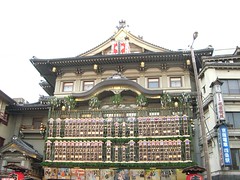Kabuki
kabuki is a popular dramatic art form that has been a favorite among the Japanese popular since the seventeenth century . It is today more popular than either noh or
bunraku, two classical dramatic forms from which it borrows heavily. Because of its assimilation of various aspects of the other dramatic art forms, kabuki might well be called a summarization of traditional Japanese theatrical art.
Kabuki does however, have a number of unique points. One of these is the mawari butai (revolving stage) which permits almost instantaneous changes of scene. Another is the hanamichi, a long, narrow, walk-like extension of the stage that runs through the audience to the back of the stage that runs through the audience to the back of the theater . Although the actors often enter and exit via the hanamichi, it is not primarily a passageway but a device for permitting the actors to come into closer contact with their audience.

Music and dancing are fundamental to the Kabuki performance. Most kabuki plays are performed to the accompaniment of typically Japanese melodies played on several shamisen (a three-stringed instrument of the lute family) and other instruments peculiar to Japan. The actors are required to follow a specific “kabuki rhythm” pattern are required to follow a specific “kabuki rhythm” pattern in both their speech and their moviments. Differing greatly from modern drama which lays primary emphasis on realism, kabuki is a formalized art in which the significance of omissions, exaggerations and many of the actors movements is pre-defined.
Anyone watching kabuki for the first will no doubt be surprised to learn that all roles, including those of female characters, are played by men. He will also be amazed by the rapidity with which the actors change costumes, often transforming themselves into totally different characters in a matter of seconds.
By subject matter, kabuki plays fall into two categories: those which deal with the fortunes of the noble and warrior classes and those which depict the lives of the common people.
The art of kabuki acting is passed on from father to son and training begins at a very early age. The actor is considered more important than the play but the play is changed to fit his particular skills.
【日本語訳】
歌舞伎
歌舞伎は17世紀から盛んになった日本の代表的な庶民演劇である。現在、能や文学よりも愛好者が多い。能や文楽の要素も取り入れているので、日本の伝統芸能の集大成的なものといえる。
歌舞伎の舞台装置には、花道や周り舞台など独特のものがある。花道は舞台に向けて観客席を貫いて設けられた通路である。これは俳優が登場、退場するためだけでなく、俳優と観客との交流をも目的としている。
演劇としての性格からいえば、歌舞伎は音楽劇であり、舞踊劇である。その多くの作品が三味線などによる日本固有の音曲を伴奏とし、台詞にも動作にも独特の音楽的リズム感が要求される。そして、省略、誇張、形式化された動きが一つの様式を生み出し、近代的リアリズムに立脚する演劇とは大きく異なっている。
男優が女性の役に扮することや、瞬間的な衣装替えの技巧なども特色の一つである。歌舞伎の主題には昔の貴族や武士の世界を描くものと、庶民の生活を描く物との2種類がある。
歌舞伎の俳優は、先祖の芸を受け継ぐよう幼少から育てられ、脚本に従って演ずるというよりは俳優の芸を中心に脚本が作られる。



